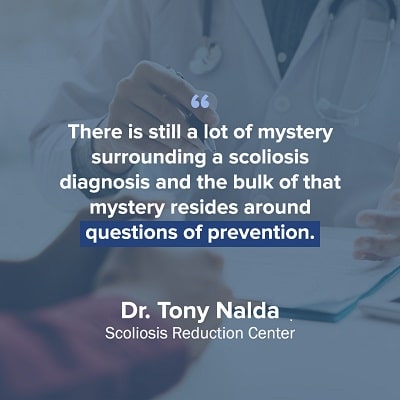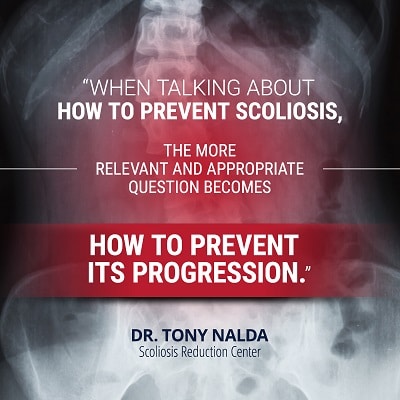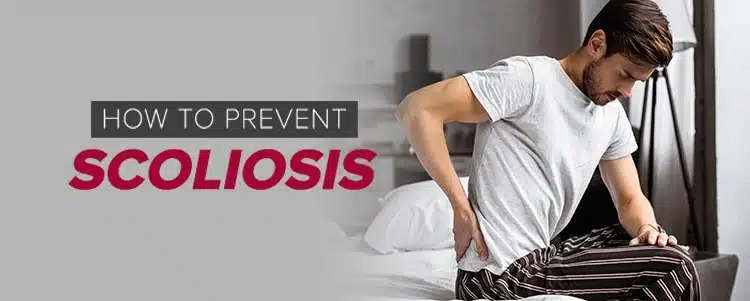It’s hard when people come to me looking for an answer on how to prevent scoliosis. This is difficult because the simple truth is there’s nothing anyone can do to prevent it, which is not what anyone wants to hear.
Why People are Asking the Question

There is still a lot of mystery surrounding a scoliosis diagnosis and the bulk of that mystery resides around questions of prevention.
Some people approach me with concern because they have someone in the family with a diagnosis and want to know what, if anything, they can do to lessen their chances of developing the condition. Others are parents and caregivers wanting to know how they can be proactive in helping to prevent their loved ones from developing the condition.
I explain that there’s very little evidence to support the inheritability of the condition. This data comes from twin studies that show one twin with the condition, but not the other.
I also get that, as a society, we equate prevention with understanding and control, so a lot of people are really focused on the question of how to prevent scoliosis for themselves and their loved ones.
4 Key Takeaways
- Unpreventability of Scoliosis: Scoliosis, primarily idiopathic in nature, cannot be prevented due to its largely unknown causes. This reality challenges common desires for control and prevention, especially among those with familial or personal concerns about the condition.
- Focus on Progression Prevention: While scoliosis itself cannot be prevented, efforts can be directed towards preventing or slowing the condition’s progression through proactive treatment strategies rather than waiting for the condition to worsen.
- The Importance of Early and Active Intervention: Adopting a proactive and multifaceted treatment approach from the time of diagnosis can offer better outcomes. This includes scoliosis-specific chiropractic care, exercise therapy, rehabilitation, and custom bracing, tailored to individual patient needs and lifestyle.
- Empowering Patients with Hope and Action: The traditional “watch and wait” approach is contrasted with a more dynamic, patient-centered method that encourages maintaining a normal lifestyle and physical activity during treatment. This philosophy supports a positive mindset, quality of life, and engagement with one’s own treatment and management of scoliosis.
Idiopathic Scoliosis
The short answer to the question is that there is no known way to prevent scoliosis because the vast majority of cases are idiopathic. ‘Idiopathic’ means there is no known single cause, and idiopathic scoliosis accounts for 80 percent of overall cases.
Scoliosis as a Symptom of Another Cause
I like to use the example of a fever when explaining the complexity of scoliosis. When you think of someone spiking a fever, the fever is a symptom of another cause, or a combination of causes, and scoliosis is the same. The condition itself is unpreventable because it can be the result of a whole host of factors, many of which are unknown.
Some known causes of scoliosis:
- Cerebral palsy
- Muscular Dystrophy
- Traumatic scoliosis caused by an accident
- Spinal degeneration
These known causes, however, only account for less than 20 percent of overall cases, so regarding the question of preventability, we’ll focus on the bulk of overall cases that are categorized as idiopathic.
The Challenge of a Scoliosis Diagnosis
Understandably, people struggle with any idiopathic-condition diagnosis. It’s hard enough for my patients and caregivers to deal with the feelings of powerlessness that accompany a scoliosis diagnosis, let alone hearing that there’s no known cause.
At the Scoliosis Reduction Center®, my team and I use our form of treatment to help patients gain back feelings of control over their bodies. We show them that with hard work, they can live their best lives and play an integral role in how their curvature progresses or doesn’t progress, after that initial diagnosis.
How to Prevent Progression

When talking about how to prevent scoliosis, the more relevant and appropriate question becomes how to prevent its progression. Once you or a loved one has received a scoliosis diagnosis, the next big step is to determine the best course of treatment for stopping or slowing down the curve’s progression.
How Posture can Change with Progression
The trickiest thing about scoliosis is that unless you’re a specialist or someone specifically looking for symptoms, spinal curvatures aren’t generally noticed until they produce significant changes to the body:
- Asymmetrical shoulders
- Arms that don’t seem to hang the same
- Asymmetrical hips
- Rib hump
- A tilting appearance of the body
Diagnosing Adolescent Scoliosis
Most scoliosis cases are adolescents and Adolescent Scoliosis is generally a painless condition. Pain tells us when something wrong is happening in the body and prompts us to get help. Without that big signifier, it’s hard for individuals, parents, caregivers, and even doctors who aren’t scoliosis specialists to recognize the existence of the condition.
Traditional Treatment
In the majority of scoliosis cases that receive traditional treatment, that treatment really doesn’t start until the spinal curvature progresses past 25 degrees and that’s 15 degrees away from reaching a surgical-level curve. While a 10- to 15-degree curve will give subtle signs, most people aren’t seeking help for themselves or loved ones until the curve has already progressed to a noticeable degree.
Time is Valuable
I feel like the traditional approach of watching and waiting to see if and how much a curve progresses over time is wasting valuable time. That time could be spent proactively working on how to stop or slow the curve’s progression and achieve a reduction.
Growth Spurts = Curvature Progression
The important thing to remember is that no one is going to simply grow out of an abnormal curvature and that these curvatures are progressive. Especially in cases of adolescent scoliosis, which happen to represent the largest group of diagnosed cases, waiting is particularly dangerous because rapid – growth of the body, through stages like puberty, can equal rapid curvature progression.
Periodic X-rays to track the curvature’s advancement until it’s progressed to a point where surgery is necessary is not the only treatment option that’s available, and that point is what I want every patient, parent, caregiver, and reader to come away with.
Chiropractic-Centered Functional Approach
Developing a course of treatment with the aim of stopping or slowing the progression of a patient’s curvature and achieving a reduction can be as multifaceted as the conditions that led to its development. This is where our patient-centered approach at the Scoliosis Reduction Center® comes into play as we customize a chiropractic-centered functional approach that works best for each and every patient.
People find success working with us because we provide access to multiple forms of treatment:
- Scoliosis-specific chiropractic care
- Exercise therapy
- Rehabilitation
- Custom 3-D bracing
My Scoliosis Reduction Center® team also takes into account multiple patient factors to ensure our treatment plan is fully customized to the individual and offers the best chances of a reduction and successful treatment:
- Age and mindset of the individual
- Physical fitness level at the time of diagnosis
- Support system
- Lifestyle
- Patient’s expectations of the condition
- Patient’s expectations of treatment
Why are all these factors so important to us? Because achieving a curvature reduction isn’t our sole focus. We want to develop a treatment plan designed to allow our patients to keep living their best lives and maintaining functionality while working towards that reduction.
Our multi-disciplinary approach enables patients to keep enjoying the physical activities they love while learning to manage their scoliosis and gain feelings of control, positivity, and hope.
Action vs. Inaction
This functional approach goes against the grain of the traditional watch-and-wait strategy that most doctors, specialists, and surgeons recommend. Not only is this approach a passive one, but it also often involves restricting a patient’s physical activity which can have numerous negative effects on a number of levels.
Mindset and Quality of Life are Important Throughout Treatment
When a doctor recommends that a patient with a scoliosis diagnosis watches and waits, there is often an accompanying recommendation to limit or halt certain types of physical activity.
Let’s think for a moment how that would impact a 16-year-old boy whose passion and whole life is athletics. Would that recommendation give him feelings of control, positivity, and hope for a bright future, or would it negatively impact his mindset, cause feelings of helplessness, and also decrease his overall health and wellness? The answer to that seems obvious to me, as I’m sure it does to you.
We appreciate and understand the importance of maintaining a healthy mindset and body throughout treatment and that’s what we want to establish for each and every patient that walks through our door.
When a patient comes to us with a scoliosis diagnosis, or when we diagnosis someone, we want to act right away, rather than watching and waiting: action vs. inaction.
Conclusion
I get that it’s hard for patients and caregivers to take that step away from traditional treatment and accept that scoliosis isn’t preventable, which is why I wrote Scoliosis Hope. I want to empower people with the knowledge that there is another way, another possible treatment plan that doesn’t inevitably lead to painful, risky, and expensive surgery that can bring further complications down the road.
There is a better way than simply waiting and observing, a more active way that allows patients to feel engaged with their treatment and condition in a positive way. I want to draw attention to the fact that a scoliosis diagnosis doesn’t have to mean living a life of physical limitations and passivity and it most certainly doesn’t have to define a person.
Waiting for any type of condition to get worse, as a doctor, seems counterintuitive to me; yet that’s still the backbone of the traditional approach most commonly used today.
Through spreading Scoliosis Hope and our treatment at the Scoliosis Reduction Center®, I’m working towards changing the narrative of our patient’s scoliosis stories, and by joining in this discussion, you too can be a part of that change.




